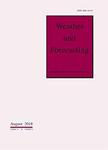版权所有:内蒙古大学图书馆 技术提供:维普资讯• 智图
内蒙古自治区呼和浩特市赛罕区大学西街235号 邮编: 010021

作者机构:Univ Oklahoma Cooperat Inst Mesoscale Meteorol Studies Norman OK 73019 USA NOAA OAR Natl Severe Storms Lab Norman OK 73069 USA
出 版 物:《WEATHER AND FORECASTING》 (天气与预报)
年 卷 期:2016年第31卷第1期
页 面:43-55页
核心收录:
学科分类:07[理学] 070601[理学-气象学] 0706[理学-大气科学]
基 金:NOAA/Office of Oceanic and Atmospheric Research under NOAA-University of Oklahoma Cooperative Agreement U.S. Department of Commerce [NA11OAR4320072]
主 题:Forecasting Radars/Radar observations Observational techniques and algorithms Forecasting Operational forecasting
摘 要:The 2013 Phased Array Radar Innovative Sensing Experiment (PARISE) investigated the impacts of higher-temporal-resolution radar data on National Weather Service forecasters warning decision processes during severe hail and wind events. In total, 12 forecasters participated in the 2013 PARISE over a 6-week period during the summer of 2013. Participants were assigned to either a control [5-min phased-array radar (PAR) updates] or experimental (1-min PAR updates) group, and worked two cases in simulated real time. This paper focuses on the qualitative retrospective reports of participants warning decision processes that were collected using the recent case walk-through method. Timelines of participants warning decision process were created for both cases, which were then thematically coded according to a situational awareness framework. Coded themes included perception, comprehension, and projection. It was found that the experimental group perceived significantly more information during both cases than the control group (case 1 p = 0.045 and case 2 p = 0.041), which may have improved the quality of their comprehensions and projections. Analysis of timelines reveals that 1-min PAR updates were important to the experimental group s more timely and accurate warning decisions. Not only did the 1-min PAR updates enable experimental participants to perceive precursor signatures earlier than control participants, but through monitoring trends in radar data, the experimental group was able to better detect storm motion, more accurately identify expected weather threats from severe thunderstorms, more easily observe strengthening and diminishing trends in storms, and make more correct tornado-related warning decisions.